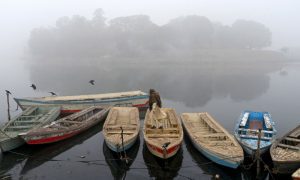[ad_1]

Recent hostilities in KP’s Kurram district have claimed the lives of 50 people and left over 200 wounded.
A property dispute in the Kurram district of Khyber Pakhtunkhwa has once again claimed the lives of around 50 people and left over 200 injured. On Monday, after six days of intense battles between two tribal groups, a ceasefire was brokered by a jirga in an effort to restore peace in the restive region.
According to the police and district administration, armed clashes between the Boshehra and Maleekhel tribesmen broke out last week. Both sides resorted to using heavy artillery and rockets to target each other’s positions, which resulted in hostilities spreading to neighbouring areas and quickly took on a sectarian colour.
These outbreaks of violence are common in the district. Last year, similar clashes claimed at least 25 lives. But the question remains: why is the violence recurring and what are the reasons behind it?
Kurram, home to a population of approximately 800,000, borders Afghanistan in the south (Khost), west (Paktika) and north (Nangarhar). In the east, it shares a border with the Orakzai district, which was also once part of erstwhile Fata (the acronym by which the Federally Administered Tribal Areas have been known since the country’s inception).
Parachinar, the district’s capital, was once called ‘Paradise on Earth’. However, difficult years have taken a toll on its now-tattered infrastructure.
Intertribal rifts
Kurram itself is comprised of three divisions: upper, central, and lower. Parachinar lies in the upper belt and is a Shia-majority town, with the Turi and Bangash tribes making up most of the population. On the hilltops surrounding the valley are the Sunni tribes.
A dispute between two tribes can often expand into a bigger problem, perpetuated by extremist organisations. Social and demographic changes over the years — the Iranian revolution, entry of Sunni Afghan refugees, and influx of weapons during the Afghan jihad are among the factors that have also contributed to the intensity and frequency of sectarian violence.
Such incidents are reported in the district every few years, with Parachinar emerging as the epicentre of the violence. What stands out is the year 2007, when deadly clashes broke out in the region, resulting in over 3,000 casualties and some 50 villages burnt. Hundreds of families were also displaced from the area.
At the time, the road to Parachinar was also cut off for several days, forcing residents to go all the way round through Kabul to re-enter Pakistan from the other side — a problem that persists to date every time the situation deteriorates.
Professor Jamil Kazmi, head of Post Graduate College Parachinar, recalled that Shias and Sunnis lived like brothers in Kurram. “But due to petty fights, where both parties suffered heavy losses, conspirators were successful in creating rifts between the two sides,” he lamented.
Speaking to Dawn.com, Malik Mahmood Ali Jan, a member of the peace committee in Kurram, explained that land disputes were a common occurrence in the district for which the government had formed a land commission last year.
“Unfortunately, the body failed to do its job and left Kurram midway,” he claimed. “Ultimately, intertribal disputes over several years over the distribution of water, cutting of wood and denial of road access have morphed into sectarian conflicts.”
Jan added that authorities too had failed to maintain law and order.
‘Evil eye’
The latest hostilities, which broke out on July 24 over a land dispute, also saw a similar fate when the situation escalated within hours. Social media platforms such as WhatsApp and Facebook were used to spread incendiary messages calling for ‘jihad’. Similar announcements were also made via loudspeakers.
Soon, ‘outsiders’ also joined the riots, spreading the violence to neighbouring villages, including Peewar, Tangi, Balishkhel, Khaar Kalay, Maqbal, Kunj Alizai, Para Chamkani, and Karman.
Subsequently, the main Parachinar Road was closed for traffic leaving hundreds of people stranded. Kurram traders said they had incurred huge losses due to the closure of roads in the district, adding that the same had led to a shortage of medicines and food items in the district.
Moreover, educational institutions were shut down and internet and mobile services were suspended.
“The people of Kurram district used to live like brothers, but we don’t know who cast an evil eye on this valley that once was paradise,” said Awami National Party (ANP) leader Pir Haider Ali Shah, who is a member of the jirga that brokered the latest ceasefire in Kurram.
“We know how the miscreants were successful … every time we come to Kurram now is for a ceasefire … instead of the picturesque views, all we see are dead bodies and injured people,” he bemoaned.
Social activists and politicians have blamed the inefficiency of the authorities and propaganda for this.
Former federal minister and PPP leader Sajid Turi recounted that he had been raising his voice for reforms in former Fata. “But the system here was changed overnight and these tribal districts were merged into the province of KP,” he said.
“We had discussed the issue but most of the promises made to us were unfulfilled, including the release of the annual development fund,” Turi complained, adding that the situation in Kurram and other areas was consequently worsening.
Jalal Bangash, head of the Bangash and Turi tribes, concurred, adding that prompt action was needed from the government to prevent criminal activities.
On the other hand, activist Mir Afzal Khan Turi said social media had fuelled fake news and hatred among the people. Abdul Khaliqa Pathan, another social worker from Kurram, stated that he was making efforts to take the message of peace to every door, be it Shia or Sunni, across the district.
Clerics and scholars in Kurram also denounced the clashes, stressing that Islam did not permit killing or torturing others and called for religious leaders to play their role in bridging the gap between the people and ending differences.
Meanwhile, Kurram Deputy Commissioner Javedullah Mehsud told Dawn.com that the latest clashes in the district came to a halt after a ceasefire agreement was reached between the warring tribes with the help of a jirga.
He said that efforts were under way to bring life back to normal in the district, adding that a number of trucks loaded with essential goods also entered Kurram last night.
Pushed into shadows
Amid flaring tensions, it is the residents of Kurram who suffer the most, particularly women, who have lost their brothers, fathers and husbands over the years.
“My brother was among the hundreds who were martyred,” said Mariam, 28, a resident of Parachinar. He became a victim of the twin blasts that shook the town in 2017.
Sajid, the sole bread earner of his family, left behind six sisters and an aged mother. “After his death, my mother took the responsibility on her shoulders and is now working as a midwife at a hospital,” Mariam told Dawn.com.
She added that with her brother gone, all of the sisters have lost their chance at education or a better life.
Education and health are two sectors in Kurram that have suffered tremendously because of the unrest. The government’s lack of attention towards colleges and universities in the district has dramatically reduced higher education opportunities for youngsters.
Separately, hospitals across the district lack the availability of equipment, qualified staff and other necessary facilities, preventing speedy treatment in urgent times.
All these reasons, combined with the recurring clashes and the government apathy, have pushed Kurram into the shadows of the region’s towering mountains, leaving children orphaned, women widowed and thousands permanently disabled.
As a Dawn editorial puts it: “The problem in Kurram, a former tribal agency bordering Afghanistan, is that the state only reacts to violence. This keeps the lid on underlying tensions for a brief period, then disputes explode at the slightest provocation.
“A long-term solution is needed to bring a more durable peace to this troubled area. It should involve the state, tribal elders as well as the clergy, as all these actors have the power to help address the root causes of violence.”
Header image: A Kalashnikov hangs from the roof of a structure in Kurram.
All photos by author
[ad_2]
Source link






